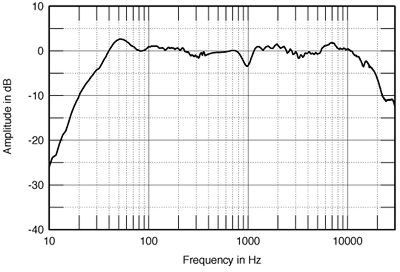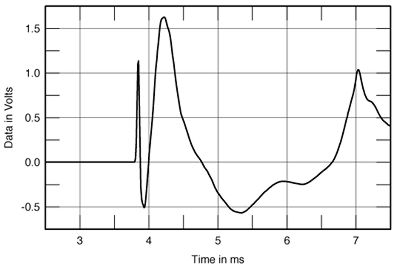| Columns Retired Columns & Blogs |
Rockport Technologies Antares loudspeaker Measurements
Sidebar 3: Measurements
The Rockport Antares weighs 400 lbs, and I was not looking forward to measuring it. Fortunately, when Andy Payor and his brother-in-law Mike delivered and unpacked one of the speakers, we were able to wheel it into my back yard, where I perform my speaker measurements, and set it down on Teflon pads, which in turn sat on a piece of carpet I had laid down over the concrete. So while I was unable to hoist the speaker onto my turntable for the off-axis measurements, I was able to rotate it with relative ease. The only unavoidable problem in the measurements concerns the inevitable reflection from the floor, which, because the speaker had to sit on the ground, occurred much earlier at the microphone than is usually the case with my speaker measurements. I indicate in the text where this was an issue.
The Antares is of slightly above-average sensitivity, at an estimated 89.3dB(B)/2.83V/m. Its plot of impedance magnitude and phase (fig.1), however, indicates that it should be rated as a 4 ohm system, the magnitude remaining between 3 and 6 ohms over almost the entire audioband.

Fig.1 Rockport Antares, electrical impedance (solid) and phase (dashed). (2 ohms/vertical div.)
While there are various undulations in the fig.1 traces that will be mainly due to the crossover filters, the traces are free from the glitches and wrinkles that would imply the presence of enclosure resonances. And, as you can see from fig.2 (a cumulative spectral-decay plot calculated from the output of a simple plastic-tape accelerometer fastened to the back panel above the port), the heroic construction of the Antares' cabinet reduces panel resonances to below the resolving power of my measurement.

Fig.2 Rockport Antares, cumulative spectral-decay plot of accelerometer output fastened to rear panel above reflex port. (MLS driving voltage to speaker, 7.55V; measurement bandwidth, 2kHz.)
The "saddle" at 22Hz indicates the tuning frequency of the large, rear-mounted port, suggesting good bass extension. This is confirmed by fig.3, which shows the individual responses of the midrange unit, woofer, and port, measured in the nearfield. The red trace is the woofer's output, and a sharp notch can be seen at the port tuning frequency. However, this graph suggests that that frequency is 28Hz rather than the 22Hz implied by the impedance graph. Perhaps as result of this mismatch, the port's output (blue trace) covers a wider bandpass than is usually the case. The woofer appears to cross over to the midrange unit (green) around the specified 130Hz, though the filter slopes are asymmetric. The woofer also appears to have some output in the midrange, though this is suppressed by the crossover.

Fig.3 Rockport Antares, nearfield responses of midrange unit (green), woofer (red), and port (blue), plotted below 1kHz, 1kHz, and 700Hz, respectively.
Fig.4 shows the complex sum of these nearfield responses (taking into account acoustic phase and the physical separation of the radiators), spliced at 350Hz to the Antares' farfield response, averaged across a 30 degrees lateral window on the tweeter axis. Overall, the Antares offers extremely flat response, though the small notch that can be seen at 1kHz might be a diffraction effect. The slight bump in the midbass is possibly due to the nearfield measurement conditions, though it might also have a contribution from the extended port output. The Antares' bass output is down by the expected 6dB at the port tuning frequency of 28Hz, but in a typical room, the usual boundary reinforcement will extend the lows to around 20Hz.

Fig.4 Rockport Antares, anechoic response on tweeter axis at 50", averaged across 30 degrees horizontal window and corrected for microphone response, with the complex sum of the nearfield responses plotted below 350Hz.
The tweeter appears to start its HF rolloff a little earlier than usual, but this is primarily due to the off-axis contribution to this spatially averaged graph. The plot of lateral dispersion (fig.5, taken out only to ±15 degrees limits rather than my usual ±90 degrees, due to the speaker's bulk) shows that the tweeter does become quite directional above 14kHz or so, due both to the larger-than-usual diaphragm size and the slight recess around the drive-unit. This will make the Antares sound a little mellow in very large rooms. But you can see that, at lower frequencies, the Antares offers very little change in its balance as the listener moves to the side, at least over the plotted range. In the vertical plane (fig.6), a suckout develops at the upper crossover frequency of 2.2kHz for standing listeners, but again, the balance does not change significantly over a fairly wide listening window.

Fig.5 Rockport Antares, lateral response family at 50", from back to front: differences in response 15 degrees-5 degrees off-axis, reference response on tweeter axis, differences in response 5 degrees-15 degrees off-axis.

Fig.6 Rockport Antares, vertical response family at 50", from back to front: differences in response 15 degrees-5 degrees above tweeter axis, reference response, differences in response 5 degrees-10 degrees below tweeter axis.
In the time domain, the Rockport's step response (fig.7) reveals that all three drive-units are connected with the same positive acoustic polarity, but that the speaker is not time-coherent. The reflections of the speaker's output from the floor can be seen just before the 6ms and 7ms marks.

Fig.7 Rockport Antares, step response on tweeter axis at 50" (5ms time window, 30kHz bandwidth).
Finally, the Antares' waterfall plot (fig.8), taken in the farfield on the tweeter axis, and with the floor reflections windowed out, is superbly clean throughout the treble. When I auditioned the Rockport speakers in Michael Fremer's listening room, I was impressed with the clarity and transparency of their presentation, as well as by their lack of coloration. The late Spencer Hughes once said that "big speakers can make big mistakes." The Rockport Antares shows that they don't always.—John Atkinson

Fig.8 Rockport Antares, cumulative spectral-decay plot at 50" (0.15ms risetime).
- Log in or register to post comments




































